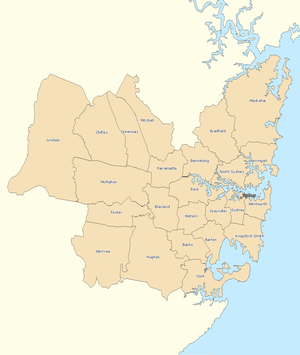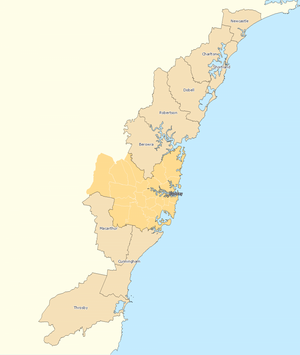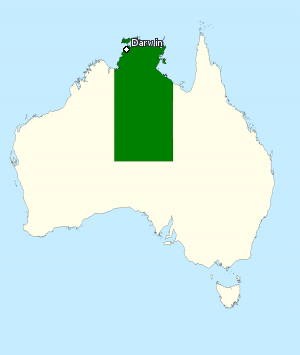Electorates of the Australian House of Representatives: Difference between revisions
Enthusiast01 (talk | contribs) No edit summary |
Enthusiast01 (talk | contribs) No edit summary |
||
| Line 4: | Line 4: | ||
==Apportionment== |
==Apportionment== |
||
Section 24 of the [[Constitution of Australia]] requires that the total number of members of the Australian House of Representatives shall be "as nearly as practicable" twice as many as the number of members of the [[Australian Senate]]. It also requires electorates to be single member. |
|||
Electorates are apportioned among the [[states and territories of Australia]] in accordance with section 24 of the [[Constitution of Australia]] and the ''Commonwealth Electoral Act 1918''.<ref>Australian Electoral Commission.[http://www.aec.gov.au/About_AEC/publications/Strategy_Research_Analysis/paper4/page03.htm ''Research Report 4 - Australian Federal Redistributions 1901-2003.''] Accessed 5 May 2008.</ref> Generally, apportionment among the states and territories is based on population, with the following provisos: |
Electorates are apportioned among the [[states and territories of Australia]] in accordance with section 24 of the [[Constitution of Australia]] and the ''Commonwealth Electoral Act 1918''.<ref>Australian Electoral Commission.[http://www.aec.gov.au/About_AEC/publications/Strategy_Research_Analysis/paper4/page03.htm ''Research Report 4 - Australian Federal Redistributions 1901-2003.''] Accessed 5 May 2008.</ref> Generally, apportionment among the states and territories is based on population, with the following provisos: |
||
*Each original state must have at least 5 Members of Parliament (a provision that gives [[Tasmania]] more representation than its population would suggest) |
*Each original state must have at least 5 Members of Parliament (a provision that gives [[Tasmania]] more representation than its population would suggest) |
||
*The [[Northern Territory]] is allocated slightly more representation under recent legislative amendments{{Fact|date=May 2008}} |
*The [[Northern Territory]] is allocated slightly more representation under recent legislative amendments{{Fact|date=May 2008}}. |
||
*The Constitution mandates that the House of Representatives should be approximately twice as large as the [[Australian Senate|Senate]] |
|||
Within each state and territory, boundaries must be redrawn in a process known as ''redistribution'' at least once every 7 years, or when the state's entitlement to the number of members of the House of Representtives change. Boundaries are drawn by Redistribution Committee, and apportionment within a state is on the basis of the number of ''enrolled voters'' rather than total residents. |
Within each state and territory, boundaries must be redrawn in a process known as ''redistribution'' at least once every 7 years, or when the state's entitlement to the number of members of the House of Representtives change. Boundaries are drawn by Redistribution Committee, and apportionment within a state is on the basis of the number of ''enrolled voters'' rather than total residents. |
||
Revision as of 06:50, 3 January 2013
Electoral divisions for the Australian House of Representatives are commonly known as electorates, seats or divisions. There are currently 150 single-member electorates for the Australian House of Representatives.
Apportionment
Section 24 of the Constitution of Australia requires that the total number of members of the Australian House of Representatives shall be "as nearly as practicable" twice as many as the number of members of the Australian Senate. It also requires electorates to be single member.
Electorates are apportioned among the states and territories of Australia in accordance with section 24 of the Constitution of Australia and the Commonwealth Electoral Act 1918.[1] Generally, apportionment among the states and territories is based on population, with the following provisos:
- Each original state must have at least 5 Members of Parliament (a provision that gives Tasmania more representation than its population would suggest)
- The Northern Territory is allocated slightly more representation under recent legislative amendments[citation needed].
Within each state and territory, boundaries must be redrawn in a process known as redistribution at least once every 7 years, or when the state's entitlement to the number of members of the House of Representtives change. Boundaries are drawn by Redistribution Committee, and apportionment within a state is on the basis of the number of enrolled voters rather than total residents.
Within a state or territory, the number of enrolled voters in each Division can not vary by more than 10% from the average across the state, nor can the number of voters vary by more than 3.5% from the average projected enrolment three-and-a-half years into the future.
Divisions are divided into four classes according to population and demographic: inner metropolitan (well-established portions of a state capital city), outer metropolitan (more recently developed portions of a state capital), provincial (divisions made up predominantly of regional cities) and rural.[2]
Naming
The Divisions of the House of Representatives are unusual in that many of them are not named after geographical features or numbered, as is the case in most other legislatures around the world. Most Divisions are named in honour of prominent historical people, such as former politicians (often Prime Ministers), explorers, artists and engineers.
In some cases where a Division is named after a geographical locality, the connection to that locality is sometimes tenuous. For instance, the Division of Werriwa, created in 1901, was named after the Aboriginal word for Lake George in the Canberra region. However, Werriwa has not contained Lake George for many decades, and has steadily moved some 200km north to the south-western suburbs of Sydney over the past century.
The redistribution, creation and abolition of Divisions is the responsibility of the Australian Electoral Commission. Some of the criteria the AEC use when naming new Divisions are listed below:[3]
- Name divisions after deceased Australians who have rendered outstanding service to their country, with consideration given to former Prime Ministers
- Retain the original names of Divisions proclaimed at Federation in 1901
- Avoid geographical place names
- Where appropriate use Aboriginal names
- Do not duplicate names of state electoral districts
List of Commonwealth Electoral Divisions, 2010-
The maps below show the Division boundaries as they existed at the Australian federal election, 2010.
New South Wales
There are 48 Divisions:
 |
 |
 |
Victoria
 |
 |
 |
There are 37 Divisions:
Queensland
There are 30 Divisions:
 |
 |
 |
Western Australia
There are 15 Divisions:
 |
 |
 |
- Brand
- Canning
- Cowan
- Curtin
- Durack
- Forrest
- Fremantle
- Hasluck
- Moore
- O'Connor
- Pearce
- Perth
- Stirling
- Swan
- Tangney
South Australia
There are 11 Divisions:
 |
 |
Tasmania
There are 5 Divisions:
 |
The Territories
 |
 |
 |
Australian Capital Territory
There are 2 Divisions:
- Canberra
- Fraser (also covers Jervis Bay Territory)
Northern Territory
There are 2 Divisions:
- Lingiari (also covers Christmas Island and Cocos (Keeling) Islands)
- Solomon
Abolished Divisions
These Australian electoral divisions no longer exist.
See also
- For a list of members of the current House of Representatives and the electorates they represent, see List of members of the Australian House of Representatives.
- For a description of how the House of Representatives is elected, see Australian electoral system.
External links
- For an electoral history of each Division since Federation in 1901, see Adam Carr's Electoral Archive: Index of House of Representatives Divisions 1901-2001
Notes
- ^ Australian Electoral Commission.Research Report 4 - Australian Federal Redistributions 1901-2003. Accessed 5 May 2008.
- ^ http://results.aec.gov.au/13745/Website/GeneralDemographicByDivision-13745-NAT.htm Demographic Classification of Divisions]
- ^ Australian Electoral Commission. Guideline for Naming Divisions. Updated 20 July 2011. Accessed 1 February 2012.
